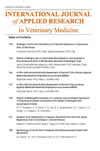饲粮中添加不同水平麦麸素对日本鹌鹑产蛋性能及蛋特性的影响
4区 农林科学
Q4 Veterinary
International Journal of Applied Research in Veterinary Medicine
Pub Date : 2023-08-19
DOI:10.31893/avr.2023015
引用次数: 0
摘要
研究了在饲料中添加不同水平麦麸氨酸对日本鹌鹑生产性能、蛋特性和脂质特性的影响。选用225只7周龄、体重为235 ~ 248 g的产蛋日本鹌鹑,采用完全随机试验设计,分为5个饲粮处理,每5个重复,每个重复9只。整个56 d的饲粮处理为:T1: 0 g Maxigrain kg-1饲粮,T2: 0.5 g Maxigrain kg-1饲粮,T3: 1 g Maxigrain kg-1饲粮,T4: 1.5 g Maxigrain kg-1饲粮,T5: 2 g Maxigrain kg-1饲粮。结果表明:饲粮处理对平均日采食量、蛋长、蛋直径、蛋形指数、胆固醇、高密度脂蛋白、低密度脂蛋白、甘油三酯、蛋白重、蛋白高和蛋黄高的影响不显著(P < 0.05),而对平均日增重、蛋重、蛋质量、蛋氨酸和蛋氨酸的影响显著(P < 0.05)。蛋黄重和蛋壳厚度均以T4和T5处理最高。由此可见,饲粮中添加T4和T5可安全提高产蛋鹌鹑的生产性能。本文章由计算机程序翻译,如有差异,请以英文原文为准。
Laying performance and egg characteristics of Japanese quail fed rations containing different levels of Maxigrain as a feed additive
The performance, egg characteristics and lipid profile of Japanese quail (Coturnix japonica) fed diets containing different levels of Maxigrain as a feed additive were investigated. A total of 225 (7 weeks) old Japanese quails weighing 235-248 g at the point of lay were allotted to 5 dietary treatments in a completely randomized experimental design with 5 replicates of 9 birds each. Dietary treatments for the entire 56 of days the feeding trial included: T1: 0 g of Maxigrain kg-1 diet, T2: 0.5 g Maxigrain kg-1 diet, T3: 1 g Maxigrain kg-1 diet, T4: 1.5 g Maxigrain kg-1 diet and T5: 2 g Maxigrain kg-1 diet. The results of the study showed that values for average daily feed intake, egg length, egg diameter, egg shape index, cholesterol, high density lipoprotein, low density lipoprotein, triglyceride, albumen weight, albumen height and yolk height were not affected by the treatment (P > 0.05), while dietary treatment significantly (P < 0.05) affected the values for the average daily weight gain, egg weight, egg mass, egg yolk weight and shell thickness among the treatments with T4 and T5 having the highest values of the above variables. It was concluded that T4 and T5 treatment could be safely included in the diet for improved performance in laying quail.
求助全文
通过发布文献求助,成功后即可免费获取论文全文。
去求助
来源期刊
自引率
0.00%
发文量
1
审稿时长
3 months
期刊介绍:
The International Journal of Applied Research in Veterinary Medicine promotes excellence in the clinical practice of veterinary medicine by disseminating fundamental scientific, diagnostic, and treatment knowledge gained from prospective and retrospective research in a timely manner. The Journal fulfills its mission through rapid peer review of each submitted article, and publication of all articles within 90 days of acceptance. All published articles meet the standards of Balance, Independence, Objectivity and Scientific Rigor.

 求助内容:
求助内容: 应助结果提醒方式:
应助结果提醒方式:


